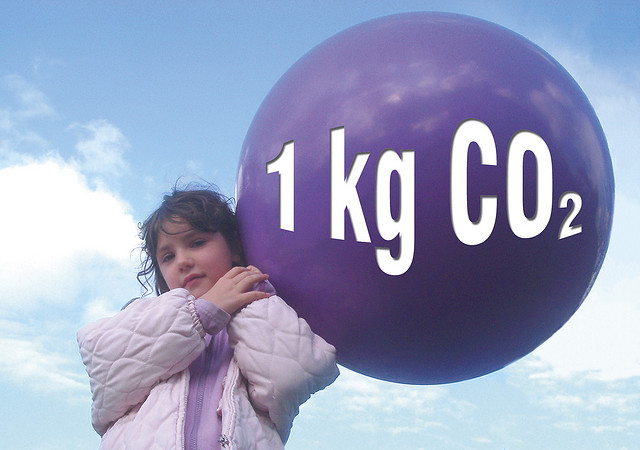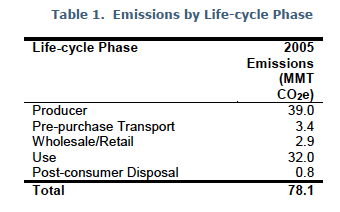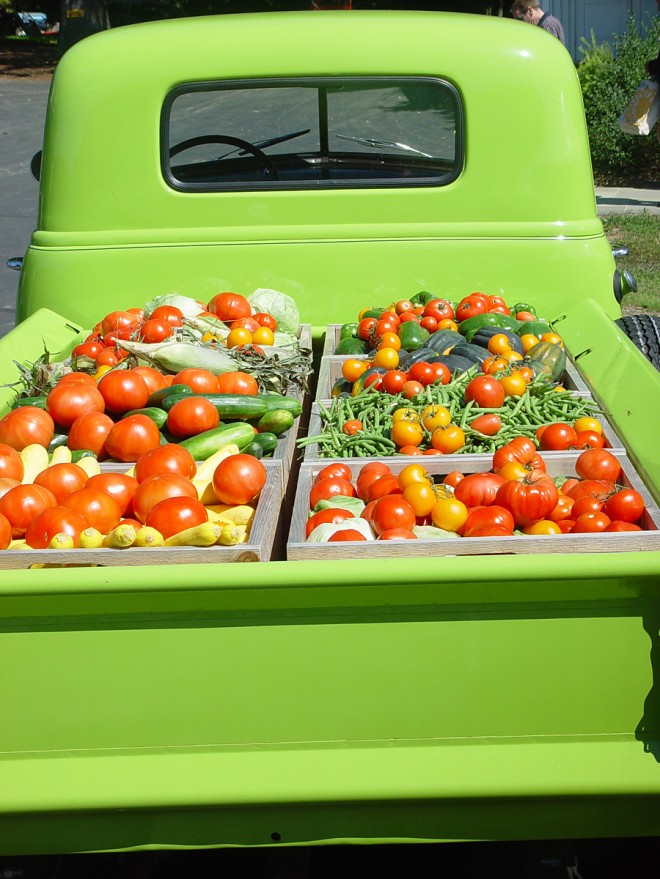What’s the “Real” Climate Footprint of Your Community?
by Lisa Mastny | February 23, 2012

Across the country, communities of all sizes are trying to measure their impact on the Earth’s climate. By taking detailed inventories of their greenhouse gas emissions (primarily carbon dioxide, but also trace gases like methane), they hope to gain a better sense of which economic activities generate the most emissions, and then take targeted action to reduce this impact.
The problem is, most existing greenhouse gas inventories have a critical flaw.
Most inventories focus only on the emissions that are produced in a region—that is, the emissions that arise locally from sources such as power plants, factories, vehicles, buildings, and agriculture. But this isn’t all—or even most—of the emissions equation. What about the “hidden” emissions associated with the countless things that residents buy and use every day, like cars, food, clothing, computers, and electricity? Shouldn’t these count toward the overall footprint, even if most of the emissions weren’t actually produced in the region? Wouldn’t this give a better sense of the true costs of our activities?
With this in mind, a handful of places are testing out a different kind of inventory that measures consumption-based emissions—the emissions associated with all the products and services that residents buy, use, and dispose of. The state of Oregon was the first community in the U.S. to commission this type of inventory, releasing its analysis last August. King County in Washington State (which includes Seattle) has since published a similar assessment, and a third project is under way for the City and County of San Francisco and the State of California.
All three studies rely on a new methodology designed by the Stockholm Environment Institute, an international research organization that helps communities build capacity for integrated sustainability planning.
Measuring consumption-based emissions has important implications, not least because it provides a clearer picture for residents, businesses, and governments about the links between their own decisions as consumers and the wider climate impacts. But it’s also relevant for discussions at the international level, as climate negotiators from around the world debate the relative responsibilities of their regions for contributing to—and addressing—global climate change.
Consumption vs. production
What makes the consumption approach so different? Consider electricity, a carbon-intensive product that we use every day. A production-based inventory would simply quantify all the carbon dioxide that’s released by a local power plant, whether or not the electricity is consumed locally or transmitted elsewhere. More importantly, it wouldn’t include many of the emissions related to this power production that may have occurred outside the region, such as the emissions released while extracting the coal or natural gas, or when transporting this fuel across borders. So it wouldn’t give a full picture of a community’s climate footprint.
A consumption-based approach, in contrast, would start from the standpoint of the actual electricity a community uses, and then calculate all the emissions associated with that use, whether they occur within or outside the region. In other words, it considers the complete electricity life cycle. By taking a lifecycle perspective, decision makers can more easily identify where in a product’s supply chain the emissions are concentrated (production, transport, use, disposal, etc), and where they can most effectively make reductions. We see the direct connection between our consumption and its consequences.
The Oregon example
So how does your climate footprint change when you start counting emissions related to consumption rather than production? In the case of Oregon, the footprint grew—a lot. The emissions associated with statewide consumption—at 78 million metric tons of carbon dioxide-equivalent in 2005—were significantly higher than the emissions produced solely within state boundaries; in fact, they were 47 percent higher! This reflects the fact that Oregon imports a large share of its goods and services, which are often linked to complex, emissions-intensive, supply chains. In total, about two-thirds of Oregon’s consumption-based emissions were released outside the state.
Most of these emissions can be linked to everyday consumers. According to the inventory, household consumption was responsible for 81 percent of Oregon’s emissions, business investment for 11 percent, and government consumption for 9 percent.

The study was also revealing from a lifecycle perspective. The bulk of Oregon’s consumption-based emissions occurred during two specific “life phases” of products: production (50 percent) and use (41 percent). Meanwhile, transporting all the goods and services consumed in the state—many from far corners of the globe—represented only a minor share of emissions, about 4 percent. The emissions released at retail/wholesale establishments and during the disposal of goods were also small.
What does this show us? That simply by buying a new product, we contribute to climate change: we are instantly burdened with all the emissions that were released to make that specific product. The process of using the product can also release significant emissions, especially if it’s a carbon-intensive item like a car or a furnace. This means that if we want to move toward more sustainable consumption, we’ll need to take a hard look at which products and services are particularly emissions-intensive to produce and use.
What products are the most emissions-intensive?
The Oregon study looked at a wide range of product categories, including vehicles and parts, appliances, food and beverages, construction, healthcare, electronics, lighting, furnishings, and clothing. It revealed, as most greenhouse gas inventories do, that among the biggest sources of emissions are personal vehicles and appliances (a category that includes home heating and cooling equipment). These items have particularly big climate footprints because they not only burn fossil fuels directly during their use, but they release indirect emissions associated with extracting, refining, and delivering these fuels.
The next biggest category of Oregon’s emissions was food and beverages. (Together, personal vehicles, appliances, and food and beverages accounted for half of all the greenhouse gas impacts of Oregon’s consumption.) In this case, the majority of food-related emissions occurred outside the state, during the “pre-purchase” phase of producing, processing, and packaging the food. Not surprisingly, red meat (which includes beef, pork, and lamb) and dairy and eggs released the highest pre-purchase emissions—a fact that can be attributed to the extensive feed requirements of cattle as well as to the release of methane, a potent greenhouse gas, from the digestive tracts of ruminant animals.
Looking at the lifecycle emissions of food makes it easier to see the profound impact that food waste—another growing problem—can have on the climate. In Oregon, the “upstream” emissions associated with food consumed in the state (the emissions released during food production, processing, and transport) were roughly 30 times higher than the “downstream” emissions associated with the disposal of uneaten food. This means that reducing food waste upstream—through activities like cutting back on production or avoiding excess purchasing—can significantly shrink food’s climate footprint. In contrast, managing food waste after it’s produced (by composting, for example) offers a much smaller potential for reductions.

Is "buying local" always better for the Earth’s climate?
Many environmentalists emphasize the importance of buying local as a way to minimize the ecological—and climate—impacts of a product, whether it’s an apple or a widget. In the case of food, a common concern raised is about “food miles”—the emissions associated with transporting an apple or a head of lettuce halfway across the world. But the findings of the Oregon inventory suggest that this isn’t the only factor to consider when deciding whether or not to choose local.
As mentioned earlier, transporting all the goods and services that Oregonians enjoy represents only about 4 percent of the state’s consumption-related emissions—so it’s actually a relatively minor contributor to the emissions total. The inventory suggests that the more important variable to consider when evaluating the benefits of buying local is how the item was produced, since the production phase accounts for such a substantial share of consumption-based emissions.
For instance, if the local method of producing an apple is particularly emissions intensive (if it uses high rates of chemical fertilizers or pesticides, for example), then the climate footprint of that local apple could easily be much higher than that of a long-distance apple that was produced in a less emissions-intensive way (such as being grown organically). Conversely, for some products, buying local may bring a distinct climate advantage due to relatively lower emissions during production. In Oregon, for example, locally made furnishing and supplies are about half as emissions intensive on average as similar items produced in the countries that export to Oregon.
Lessons learned, and what we can do in our own communities
Like any modeling effort, there are limitations to consumption-based inventories. For reasons of data availability, for example, the Oregon study relies on nationally derived estimates of consumer, government, and business spending and trade relationships, which are then scaled to the state level. As a result, the inventory may not reflect local behaviors that might deviate significantly from national averages. Because of these and other limitations, consumption-based inventories may be inherently less accurate than certain elements of production-based inventories that are based on direct measurement of fuel use or production. That’s why it’s recommended that most places use a consumption-based inventory to complement, not replace, traditional production-based approaches.
Nevertheless, consumption-based inventories play a critical role in empowering us as consumers—and as communities. We can gain a more complete picture of how our consumption choices contribute to local (and global) greenhouse gas emissions
Among the steps we can take as consumers are:
- Shifting our vehicle, appliance, and food choices to more climate-friendly alternatives, such as switching from a standard sedan to a hybrid, using more-efficient home appliances (and turning them off when not in use), and eating fewer processed foods;
- Extending the useful life of our personal and household goods, such as furnishings and clothing, to reduce the need for new products and their associated emissions;
- Buying more durable (or secondhand) items, and delaying the purchase of new items by reusing items already in use. (For certain products like cars, appliances, or windows, however, upgrading to more-efficient models may bring greater climate benefits than prolonging their use.);
- Switching from high-emissions to low-emissions goods and services wherever possible; and
- Reducing consumption overall, either by no longer buying certain good and services or by avoiding consumption through gains in efficiency and other measures. The Oregon model suggests that for every $1 million decline in overall spending in the state, greenhouse gas emissions would decline by approximately 540 tons.
Steps for policymakers and other community decision makers include:
- Focusing waste prevention efforts on reduced and shifted consumption as a means of preventing waste and conserving resources;
- Encouraging extended producer responsibility or “product stewardship” and working with manufacturers to reduce environmental and health impacts across the entire life cycle of their product;
- Using government purchasing policies to “lead by example” and drive market change toward more climate-friendly products;
- Encouraging businesses and industries (both within and outside the region) to do their own inventories of “supply chain” emissions to help them determine where changes in technologies, energy sources, or suppliers may yield significant emissions reductions.
Clearly, if policymakers in Oregon based their climate action only on a production-based inventory, they would be missing a huge contributor to emissions in the state. This suggests that, as communities, it is in our interest not only to reduce emissions within local boundaries (such as by encouraging more sustainable consumption patterns), but also to support and encourage action beyond our borders to lower the emissions associated with producing and transporting the goods that we use. From this perspective, it is much easier to see how we are “all in this together” and must work collaboratively as communities, regions, and nations to address the local and global challenges we face.
Further Resources:
Consumption-Based Greenhouse Gas Emissions Inventory for Oregon – 2005: Summary Report
Consumption-Based Greenhouse Gas Emissions Inventory for Oregon - 2005: Technical Report
Greenhouse Gas Emissions in King County
Answers to common questions about the consumption-based emissions inventory
Calculate your household’s carbon footprint
Materials Management Approaches for State and Local Climate Protection
Lisa Mastny is Director of Communications and Online Media at New Dream.

